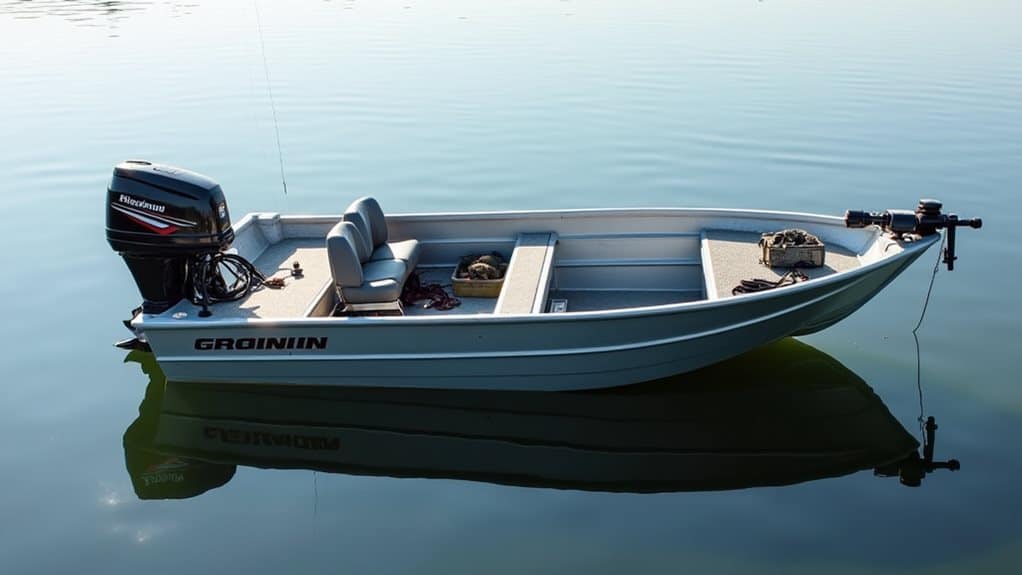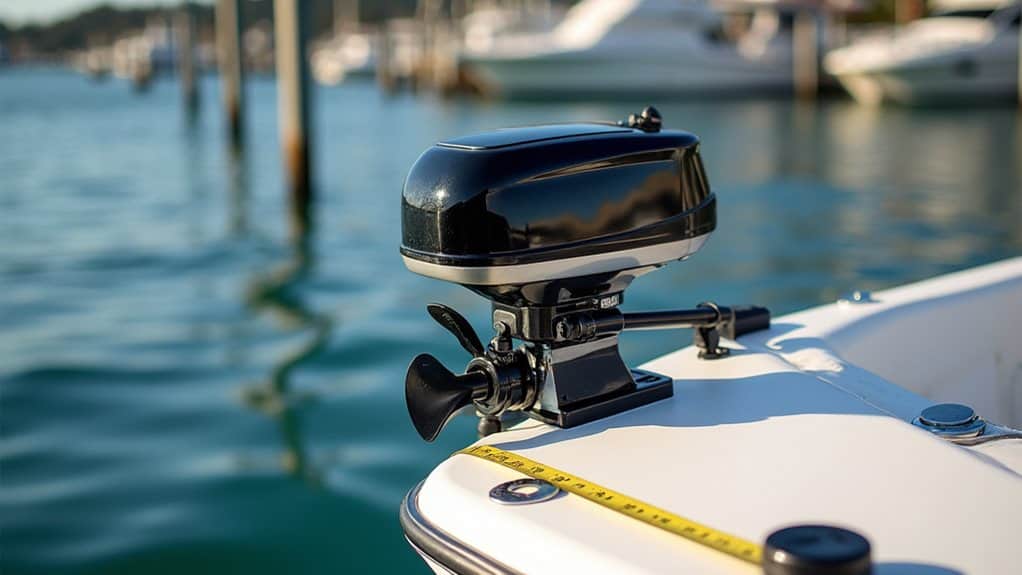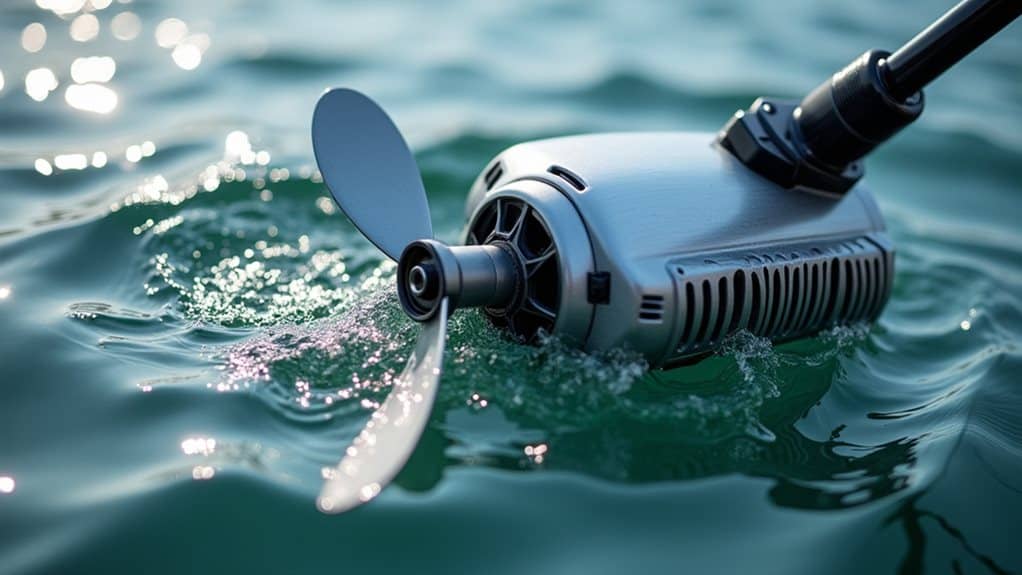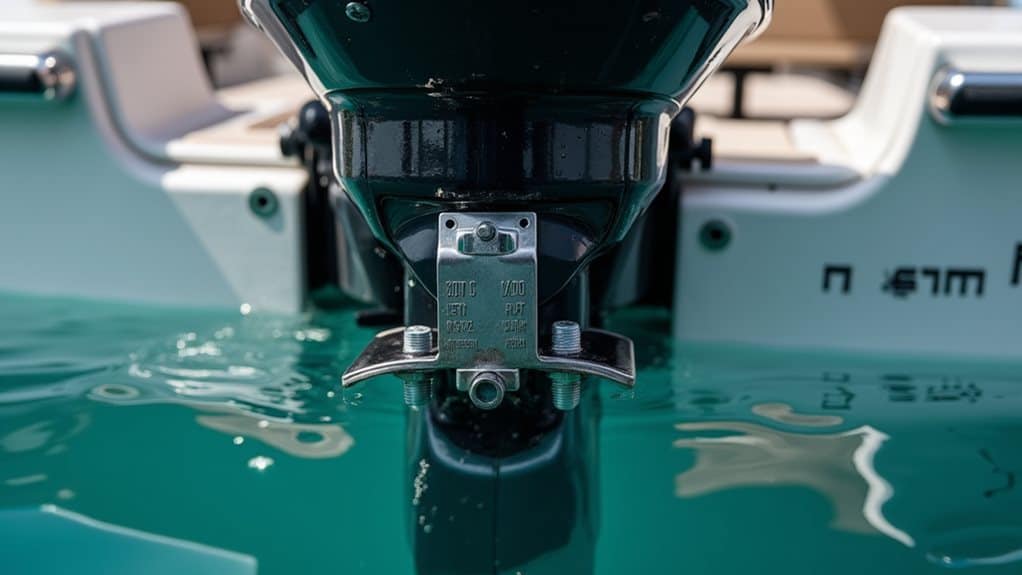You’ll need approximately 2-3 pounds of thrust for every 100 pounds of your boat’s total weight, though the common rule suggests 5 pounds of thrust per 200 pounds of boat weight. For example, a 1,000-pound vessel requires around 25-30 pounds of thrust for basic maneuverability. However, environmental factors like wind and current can reduce effectiveness by up to 50%, so consider upgrading to higher voltage systems for better performance and efficiency in challenging conditions.
TLDR
- Calculate thrust using 5 lbs per 200 lbs of boat weight or 1 lb per 50 lbs total weight.
- Boats under 14 feet need 30 lbs thrust; 15-16 foot boats require 40 lbs thrust.
- Choose 12V systems for boats under 1,000 lbs; 24V for up to 1,500 lbs; 36V for heavier vessels.
- Wind and currents can reduce motor effectiveness by 50%, requiring additional thrust for challenging conditions.
- Brushless motors provide 85-90% efficiency compared to 75-80% for brushed motors, offering better performance.
Weight-Based Thrust Calculation Methods

When selecting the right trolling motor for your boat, the most reliable starting point is calculating thrust requirements based on your vessel’s total weight.
You’ll find several proven formulas: the common 5 pounds of thrust per 200 pounds of boat weight, or the lower-end rule of 1 pound per 50 pounds of total weight. Kayak weight limits are crucial to consider when choosing your trolling motor, as they can affect overall performance. Remember that higher voltage systems like 24v and 36v configurations will deliver increased thrust capabilities compared to standard 12v motors.
Voltage Systems and Power Output Options
Once you’ve determined the thrust requirements based on your boat’s weight, you’ll need to choose the appropriate voltage system to deliver that power effectively.
Your options include 12V systems for smaller boats under 1,000 pounds, 24V systems for medium vessels up to 1,500 pounds, and 36V systems for heavier boats exceeding 1,800 pounds. Higher voltage systems provide greater efficiency and extended runtime, making them particularly beneficial for longer fishing trips and challenging water conditions. Additionally, a good small boat fish finder can complement your trolling motor by enhancing your navigation and fishing success.
Boat Size and Length Specifications

Boat dimensions serve as crucial indicators for selecting the appropriate trolling motor thrust, with both length and weight playing critical roles in determining your power requirements.
Vessels under 14′ typically need 30 lbs of thrust, while 15-16′ boats require about 40 lbs.
Boats measuring 17′-18′ often need 40-45 lbs, and those over 21′ may require 90+ lbs of thrust. Additionally, it’s important to consider factors such as weather forecasts which can influence your boating conditions and requirements.
Environmental Conditions Impact on Performance
While selecting the right thrust based on your boat’s specifications provides a solid foundation, environmental conditions will ultimately determine how well your trolling motor performs on the water.
Wind resistance can reduce your motor’s effectiveness by up to 50%, while strong currents force your motor to work harder, draining battery power faster and compromising overall performance. Additionally, understanding proper paddling techniques can help in managing your boat’s movement against these external factors.
Motor Technology and Efficiency Features

When you’re selecting a trolling motor, understanding the technological differences between brushless and brush motors can greatly impact your fishing experience and long-term costs.
Modern trolling motors also offer dual voltage systems that provide flexibility in power management, allowing you to optimize performance based on your specific needs and battery setup.
Additionally, today’s advanced steering features, including GPS guidance and virtual anchoring capabilities, change how you position and maneuver your boat on the water.
Brushless Vs Brush Motors
Motor technology has evolved markedly in recent years, and the choice between brushless and brushed motors represents one of the most important decisions you’ll make when selecting a trolling motor.
Brushless motors offer superior efficiency, exceeding 85-90% compared to brushed motors’ 75-80%. They’re quieter, require less maintenance, and provide longer battery runtime, though they cost more upfront.
Dual Voltage Systems
Beyond the motor’s internal mechanics, the electrical system powering your trolling motor plays an equally important role in determining performance and efficiency.
Dual voltage systems let you select between voltage inputs, like 24V for 80 lbs thrust or 36V for 100 lbs thrust, optimizing power based on your boat’s size and fishing conditions.
Advanced Navigation Features
Although thrust remains the primary consideration when selecting a trolling motor, today’s advanced guidance features convert these motors from simple propulsion devices into sophisticated boat-positioning systems.
You’ll find AutoPilot maintains your heading automatically, while Spot-Lock holds precise positions for fishing.
BackTrack lets you retrace paths, and Dodge Mode temporarily avoids obstacles before resuming course.
Installation Requirements and Maintenance Guidelines

When installing your trolling motor, you’ll need to focus on three critical areas that directly impact performance and longevity.
First, proper battery wiring setup guarantees your motor receives consistent power while preventing electrical issues that could leave you stranded on the water.
Additionally, selecting the correct shaft length and establishing a regular maintenance routine will maximize your motor’s efficiency and extend its operational life considerably.
Proper Battery Wiring Setup
Establishing a reliable battery wiring setup for your trolling motor requires careful attention to both the initial installation and ongoing maintenance to guarantee peak performance on the water.
You’ll need batteries of identical age, size, type, and manufacture for proper connections.
Use marine-grade cables and apply dielectric grease to prevent corrosion while ensuring secure cable management throughout your system.
Shaft Length Selection
With your battery system properly configured, selecting the correct shaft length becomes your next priority for ideal trolling motor performance.
You’ll need to measure from the motor mount point to the waterline, then add 5″ to 12″ extra allowance for full propeller submersion.
Small boats typically require 36″ to 42″ shafts, while medium-sized boats need 42″ to 50″ lengths.
Regular Maintenance Checks
Once your trolling motor is properly installed, establishing a routine maintenance schedule becomes essential for maximizing its lifespan and ensuring peak performance on the water.
You’ll need to clean the motor regularly, inspect wires and cables for damage, monitor battery health, check the propeller for fouling, and test electronic systems for proper function.
Final Note
You’ll find the right trolling motor thrust by calculating two pounds per 100 pounds of boat weight, then adjusting for your specific conditions. Consider your boat’s length, typical wind and current conditions, and whether you’re fishing in saltwater. Don’t forget that higher voltage systems provide better efficiency, while modern brushless motors offer superior performance. Match these factors to your fishing style, and you’ll select a motor that delivers reliable, quiet propulsion for successful trolling escapades.




